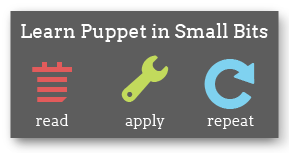Puppet Internals - How It Works
The goal of this document is to describe how a manifest you write in Puppet gets converted to work being done on the system. This process is relatively complex, but you seldom need to know many of the details; this document only exists for those who are pushing the boundaries of what Puppet can do or who don’t understand why they are seeing a particular error. It can also help those who are hoping to extend Puppet beyond its current abilities.
High Level
When looked at coarsely, Puppet has three main phases of execution – compiling, instantiation, and configuration.
Compiling
Here is where we convert from a text-based manifest into a node-specific specification. Any code not meant for the host in question is ignored, and any code that is meant for that host is fully interpolated, meaning that variables are expanded and all of the results are literal strings.
The only connection between the compiling phase and the library of Puppet resource types is that all resulting resource specifications are verified that the referenced type is valid and that all specified attributes are valid for that type. There is no value validation at this point.
In a networked setup, this phase happens entirely on the server. The output of this phase is a collection of very simplistic resources that closely resemble basic hashes.
Instantiation
This phase converts the simple hashes and arrays into Puppet library objects. Because this phase requires so much information about the client in order to work correctly (e.g., what type of packaging is used, what type of services, etc.), this phase happens entirely on the client.
The conversion from the simpler format into literal Puppet objects allows those objects to do greater validation on the inputs, and this is where most of the input validation takes place. If you specified a valid attribute but an invalid value, this is where you will find it out, meaning that you will find it out when the config is instantiated on the client, not (unfortunately) on the server.
The output of this phase is the machine’s entire configuration in memory and in a form capable of modifying the local system.
Configuration
This is where Puppet actually modifies the system. Each of resource instance compares its specified state to the state on the machine and make any modifications that are necessary. If the machine exactly matches the specified configuration, then no work is done.
The output of this phase is a correctly configured machine, in one pass.
Lower Level
These three high level phases can each be broken down into more steps.
Compile Phase 1: Parsing
Inputs: Manifests written in the Puppet language
Outputs: Parse trees (instances of AST objects)
Entry: Puppet::Parser::Parser#parse
At this point, all Puppet manifests start out as text documents, and it’s the parser’s job to understand those documents. The parser (defined in parser/grammar.ra and parser/lexer.rb) does very little work – it converts from text to a format that maps directly back to the text, building parse trees that are essentially equivalent to the text itself. The only validation that takes place here is syntactic.
This phase takes place immediately for all uses of Puppet. Whether you are using nodes or no nodes, whether you are using the standalone puppet interpreter or the client/server system, parsing happens as soon as Puppet starts.
Compile Phase 2: Interpreting
Inputs: Parse trees (instances of AST objects) and client information (collection of facts output by Facter)
Outputs: Trees of TransObject and TransBucket instances (from transportable.rb)
Entry: Puppet::Parser::AST#evaluate
Exit: Puppet::Parser::Scope#to_trans
Most configurations will rely on client information to make decisions. When the Puppet client starts, it loads the Facter library, collects all of the facts that it can, and passes those facts to the interpreter. When you use Puppet over a network, these facts are passed over the network to the server and the server uses them to compile the client’s configuration.
This step of passing information to the server enables the server to make decisions about the client based on things like operating system and hardware architecture, and it also enables the server to insert information about the client into the configuration, information like IP address and MAC address.
The interpreter combines the parse trees and the client information into a tree of simple transportable objects which maps roughly to the configuration as defined in the manifests – it is still a tree, but it is a tree of classes and the resources contained in those classes.
Nodes vs. No Nodes
When you use Puppet, you have the option of using node resources or not. If you do not use node resources, then the entire configuration is interpreted every time a client connects, from the top of the parse tree down. In this case, you must have some kind of explicit selection mechanism for specifying which code goes with which node.
If you do use nodes, though, the interpreter precompiles everything except the node-specific code. When a node connects, the interpreter looks for the code associated with that node name (retrieved from the Facter facts) and compiles just that bit on demand.
Configuration Transport
Inputs: Transportable objects
Outputs: Transportable objects
Entry: Puppet::Network::Server::Master#getconfig
Exit: Puppet::Network::Client::Master#getconfig
If you are using the stand-alone puppet executable, there is no configuration transport because the client and server are in the same process. If you are using the networked puppetd client and puppetmasterd server, though, the configuration must be sent to the client once it is entirely compiled.
Puppet currently converts the Transportable objects to YAML, which it then CGI-escapes and sends over the wire using XMLRPC over HTTPS. The client receives the configuration, unescapes it, caches it to disk in case the server is not available on the next run, and then uses YAML to convert it back to normal Ruby Transportable objects.
Instantiation Phase
Inputs: Transportable objects
Outputs: Puppet::Type instances
Entry: Puppet::Network::Client::Master#run
Exit: Puppet::Transaction#initialize
To create Puppet library objects (all of which are instances of Puppet::Type subclasses), to_trans is called on the top-level transportable object. All container objects get converted to Puppet::Type::Component instances, and all normal objects get converted into the appropriate Puppet resource type instance.
This is where all input validation takes place and often where values get converted into more usable forms. For instance, filesystems always return user IDs, not user names, so Puppet objects convert them appropriately. (Incidentally, sometimes Puppet is creating the user that it’s chowning a file to, so whenever possible it ignores validation errors until the last minute).
Once all of the resources are built in a graph-like tree of components and resources, this tree is converted to a GRATR graph. The graph is then passed to a new transaction instance.
Configuration Phase
Inputs: GRATR graph
Outputs: Transaction report
Entry: Puppet::Transaction#evaluate
Exit: Puppet::Transaction#generate_report
This is the phase in which all of the work is done, tightly controlled by a transaction.
Resource Generation
Some resources manage other resource instances, such as recursive file operations. During this phase, any statically generatable resources are generated. These generated resources are then added to the resource graphs.
Relationships
The next stage of the configuration process builds a graph to model resource dependencies. One of the goals of the Puppet language is to make file order matter as little as possible; this means that a Puppet resource needs to be able to require other resources listed later in the manifest, which means that the required resource will be instantiated after the requiring resource. This dependency graph is then merged with the original resource graph to build a complete graph of all resources and all of their relationships.
Evaluation
The transaction does a topological sort on the final relationship graph and iterates over the resulting list, evaluating each resource in turn. Each out-of-sync property on each resource results in a Puppet::StateChange object, which the transaction uses to tightly control what happens to the resource and when, and also to guarantee that logs are provided.
Reporting
As the transaction progresses, it collects logs and metrics on what it does. At the end of evaluation, it turns this information into a report, which it sends to the server (if requested).
Conclusion
That’s the entire flow of how a Puppet manifest becomes a complete configuration. There is more to the Puppet system, such as FileBuckets, but those are more support staff rather than the main attraction.

